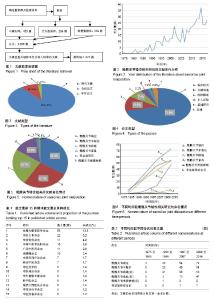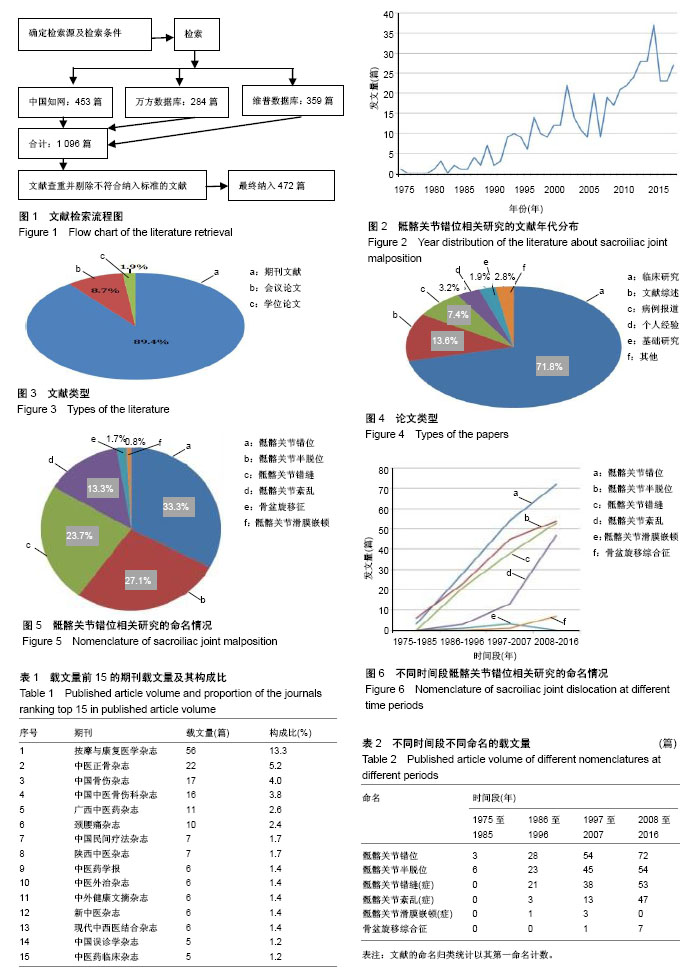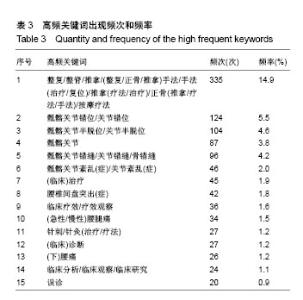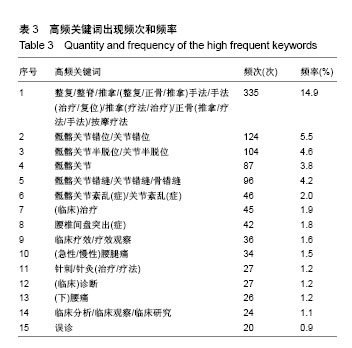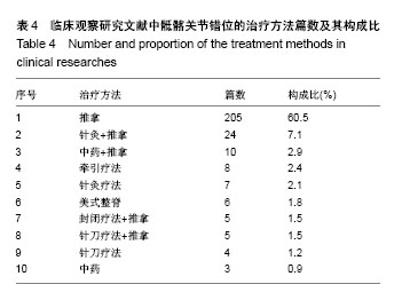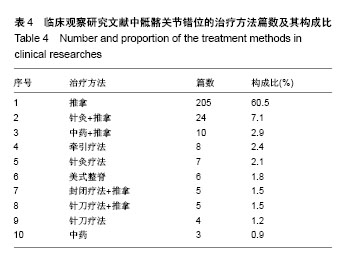| [1] 栾明拥,栾明义,汪超,等.栾氏正骨诊治骨关节错缝的特点[J].辽宁中医杂志,2002,29(8): 462-463. [2] 李义凯.软组织痛的基础与临床[M].香港:世界医药出版社,2011: 340.[3] 郭汝松,吴晓庆,王金玲,等. 基于生物力学探讨下肢后伸定点按压法治疗骶髂关节紊乱临床思考[J].辽宁中医药大学学报, 2017, 19(7):166-169. [4] 陆永雷,陈朝晖,程露露,等. 理筋正骨手法治疗骶髂关节错缝即刻效应临床观察[J].中医药临床杂志,2016,28(05):704-706. [5] 张喜林,沈国权,金喜宏,等.脊柱微调手法配合功能训练治疗骶髂关节紊乱临床总结[J].中华中医药学刊, 2015,33(11): 2580-2582. [6] 崇步伟,项志强,钟丽娜. 手法复位快捷治疗骶髂关节半脱位37例[J]. 中国中医骨伤科杂志,2013,21(06):54-55.[7] Steven PC, Chen Y, Nathan JN. Sacroiliac joint pain: a comprehensive review of epidemiology, diagnosis and treatment. Expert Rev Neurother.2013;13(1):99-116.[8] Ilaslan H, Arslan A, Koç ON, et al. Sacroiliac joint dysfunction. Turk Neurosurg. 2010;20(3):398-401.[9] Eskander JP, Ripoll JG, Calixto F, et al. Value of examination under fluoroscopy for the assessment of sacroiliac joint dysfunction. Pain Physician.2015;18(5):E781-786.[10] Zelle BA, Gruen GS, Brown S, et al. Sacroiliac joint dysfunction: evaluation and management. Clin J Pain. 2005; 21(5):446-455.[11] 师宁宁,沈国权,何水勇,等. 骶髂关节紊乱与腰椎间盘退变之间相关性的流行病学研究与生物力学分析[J].中国骨伤, 2014, 27(7):560-564.[12] 江军.骶髂关节紊乱的发病机制与临床治疗研究进展[J].职业与健康,2012,28(19): 2407-2409.[13] Murata Y, Takahashi K, Yamagata M, et al. Ofigin and pathway of senory nerve fibers to the ventral and dorsal sides of the sacroiliac joint in rat.J Orthop Res.2001;19(3):379-383. [14] 梁善皓,叶淦湖,陈焕亮,等.骶髂关节半脱位的临床研究[J].中国康复医学杂志, 2007,22(2):172-173.[15] 邹善林,潘高之胤,柯奇朝,等.推拿治疗骶髂关节错位的临床研究进展[J].黑龙江中医药,2016,45(04):75-76.[16] 周国庆.调整骶髂关节手法治疗腰椎间盘突出伴骶髂关节错位的效果[J].医学理论与践,2017,30(13):1945-1946.[17] 龙鑫,邱智兴,毛晓雯,等.骨盆按旋法治疗骶髂关节错位的机理及对脊柱平衡的影响[J].光明中医, 2015,30(03):509-512.[18] 郭汝宝,李增图,诸波,等.骨盆调整手法治疗腰椎间盘突出症伴骶髂关节错位的疗效观察[J].贵阳中医学院学报, 2015,37(2): 30-33.[19] 杨晓伟,张喜林,刘慧,等.手法治疗骶髂关节错位的研究进展[J].中国中医骨伤科杂志,2016,24(08):77-79.[20] 党彦峰.屈髋屈膝旋转扳法治疗骶髂关节半脱位疗效观察[J].陕西中医,2012,33(4):440-441.[21] 雷言坤,范炳华.推拿治疗骶髂关节半脱位的解剖学和生物力学作用机制研究进展[J].中医正骨,2011,23(1):40-42.[22] Meho L I, Yang K. Impact of data sources on citation counts and rankings of LIS faculty: Web of science versus scopus and google scholar. J Am Soc Inf Sci.2007;58(13):2105-2125.[23] 李轩,石春来,王雪艳,等.心血管支架材料生物相容性:国际发展态势的文献计量学分析[J].中国组织工程研究, 2015,19(8): 1267-1271.[24] 吴淑金,陈清.我国核心期刊研究10年专题文献计量学分析[J].实用医学杂志, 2008,24(8):1462-1465.[25] 陈庆海,黄丽文,林瑄.PubMed收录严重急性呼吸道综合征文献计量学分析[J].实用医学杂志,2010,26(11):2059-2060.[26] 柏琳,任玉兰,李宁,等.募穴在临床诊断中应用的文献计量学分析[J].中医杂志,2017,58(1):64-68.[27] 潘进社,张英泽,陈伟.骶髂关节应用解剖及生物力学研究进展[J].国际骨科学杂志,2007,28(4):237-238+260.[28] 胡中伟,陈志文,翟文亮,等.骶髂关节数字解剖学研究及弧形解剖锁定钢板的设计[J].生物骨科材料与临床研究, 2014,11(2): 13-16.[29] 钱齐荣,贾连顺.骶髂关节的解剖及生物力学研究进展[J].中国临床解剖学杂志,1997,15(3):77-79. [30] 江军.骶髂关节紊乱的发病机制与临床治疗研究进展[J].职业与健康,2012,28(19): 2407-2409. [31] 浦维卿.产后骶髂关节半脱位治疗体会[J].中国中医急症, 2011, 20(9):1511.[32] 魏文广,陈剑俊,董成伟.针刺、整脊、功能锻炼综合治疗产后骶髂关节错缝症疗效观察[J].上海针灸杂志,2017,36(1):67-70.[33] 宁艳辉,申茹萌,许常娟,等.手法整复治疗产后骶髂关节半脱位临床观察[J]. 华南国防医学杂志,2015,29(06):445-447.[34] 韦梦菲,安平,吴秀文.整脊调曲手法治疗妇女产后骶髂关节错缝后的临床护理[J]. 微创医学,2015,10(3):366-367+375.[35] 王廷臣.骶髂关节错位的理论思考[J].中国组织工程研究与临床康复,2008,12(11): 2161-2163.[36] 包新任,王琦,彭林,等.改良腰椎斜扳法治疗骶髂关节紊乱症疗效观察[J].中国全科医学,2013,16(1):310-311.[37] 范炳华,雷言坤,王鹏,等.蛙式四步扳法治疗骶髂关节半脱位[J].中国骨伤,2010,23(8):626-628.[38] 秦家超.定向复位法治疗骶髂关节错位126例疗效观察[J].中国中医急症,2013,22(10):1761-1762.[39] 吴勤峰,刘苏.美式脊椎矫正治疗骶髂关节半脱位26例疗效分析[J].延边大学医学学报,2009,32(4):298-299. |
